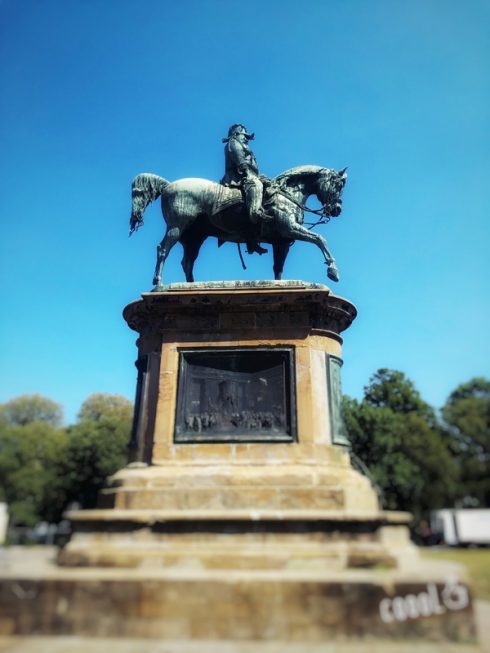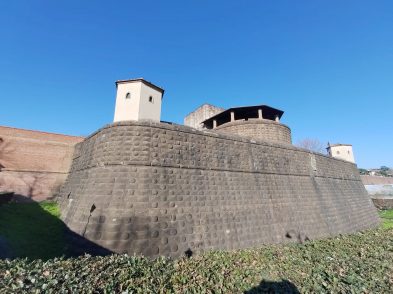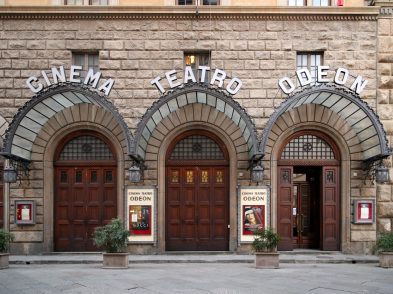Most major Italian cities and many smaller ones boast statues to Vittorio Emanuele II, the first king of the newly united Italy who reigned between 1861 and 1878. The most majestic representation of him throughout the peninsula finds him on horseback high on a magnificent, decorated marble base in front of the imposing Vittoriano, the national monument in Rome’s piazza Venezia. Although not as breathtaking as its rival in the capital, Florence’s own bronze equestrian statue of him stood for little over four decades in his namesake piazza, today known as piazza della Repubblica after the 1946 referendum. Proving to be an obstacle to the passage of traffic in the piazza, it was moved in 1932 to piazza Vittorio Veneto at the entrance to the Cascine Park, the square named after the Italian victory in the World War I battle, which, ironically, had been chosen by Giuseppe Poggi for the original monument of the king that was never realised.
Born in Turin on March 14, 1820, Vittorio Emanuele II was the son of King Carlo Alberto of Piedmont-Sardinia and Queen Maria Theresa of Austria. A vigorous man with an impressive handlebar moustache, in his youth, Vittorio Emanuele spent time in Florence cultivating his love of sport and the military, which in years to come would see him personally on the battlefield. After his father’s abdication in 1849 following his defeat by the Austrians in the First War of Independence (1848-49), Vittorio Emanuele ascended to his father’s throne. During a subsequent War of Independence (1859-61), two key factors helped his rise: the strategic political manoeuvring of prime minister Count Camillo Cavour and the military prowess of Giuseppe Garibaldi, whose victory with the Expedition of the Thousand saw the kingdom of the Two Sicilies annexed by the Kingdom of Sardinia. This resulted in the establishment of the first national government in Turin on March 17, 1861, with Vittorio Emanuele II declared King of Italy and also dubbed the “Father of the Fatherland”.
In 1859, the Tuscan provisional government held a contest to erect two equestrian statues in the city, one of Vittorio Emanuele II and the other of Emperor of the French Napoleon III, which were to be placed in piazza Maria Antonia (now called piazza dell’Indipendenza). The Livornese sculptor Salvino Salvini won the commission for the Italian king’s statue but it was never cast as the city became involved in too many other expensive projects in their quest for turning Florence into the nation’s new capital (1865-71). But, the idea of a statue dedicated to the king resurfaced after the sovereign’s death on January 9, 1878 and, in 1881, a new competition was held. The Florentine sculptor Emilio Zocchi (1835-1913), a teacher at the Florence Accademia delle Belle Arti, won it. Along with nominating the winner, the city had to decide where the monument should stand. Following Giuseppe Poggi’s redevelopment of the city, the central piazza named after the king became the obvious choice.

When Zocchi began working on his winning monument its dimensions were so big he had to build a larger studio near the Mugnone. In all, it took him eight years to complete and, apart from casting the figure of the king and his horse, he also created two bronze bas-reliefs to decorate the base of the statue, one showing the king when he received the plebiscite from the Tuscan delegation asking for its annexation to the Kingdom of Italy and the other showing Vittorio Emanuele II bidding farewell to the people as he left Florence for Rome, the new capital.
The monument was unveiled on September 20, 1890 in the presence of a large crowd in a piazza where many of the surrounding buildings were still under construction. To coincide with this, a medal bearing the king’s effigy was coined. However, despite the pomp and ceremony, the Florentines were not all that impressed with the statue and it was often either criticised or mocked.
Florentines seem fonder of another equestrian statue of Vittorio Emanuele II just outside the city limits. Sculpted by Oreste Calzolari in 1906 and situated in piazza Mino da Fiesole, the main piazza of Fiesole, it portrays Garibaldi’s meeting with the king at Teano, in the province of Caserta on October 26, 1860. The two men sitting side by side on their horses shake hands in celebration of the end of Garibaldi’s Expedition of the Thousand that ousted the Bourbon Kingdom of the Two Sicilies, thereby uniting southern Italy and Sicily with the north.







